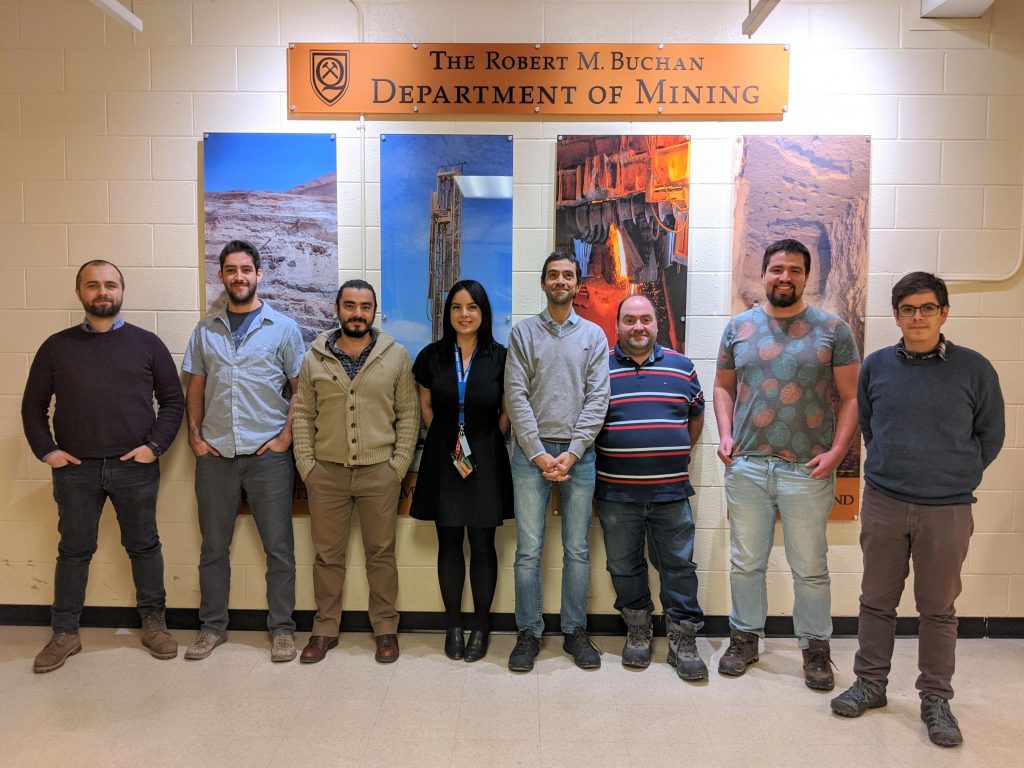On September 2, 2020, Ilkay Cevik successfully defended his M.A.Sc. in Mining Engineering thesis entitled: “Machine learning enhancements for knowledge discovery in mineral exploration and improved mineral resource classification”

Congratulations!

On September 2, 2020, Ilkay Cevik successfully defended his M.A.Sc. in Mining Engineering thesis entitled: “Machine learning enhancements for knowledge discovery in mineral exploration and improved mineral resource classification”

Congratulations!
We are happy to announce that Alvaro Riquelme received the 2020 Mathematical Geosciences Student Award, awarded for his research on Random Fields on Manifolds and Applications to Geostatistical Modelling.
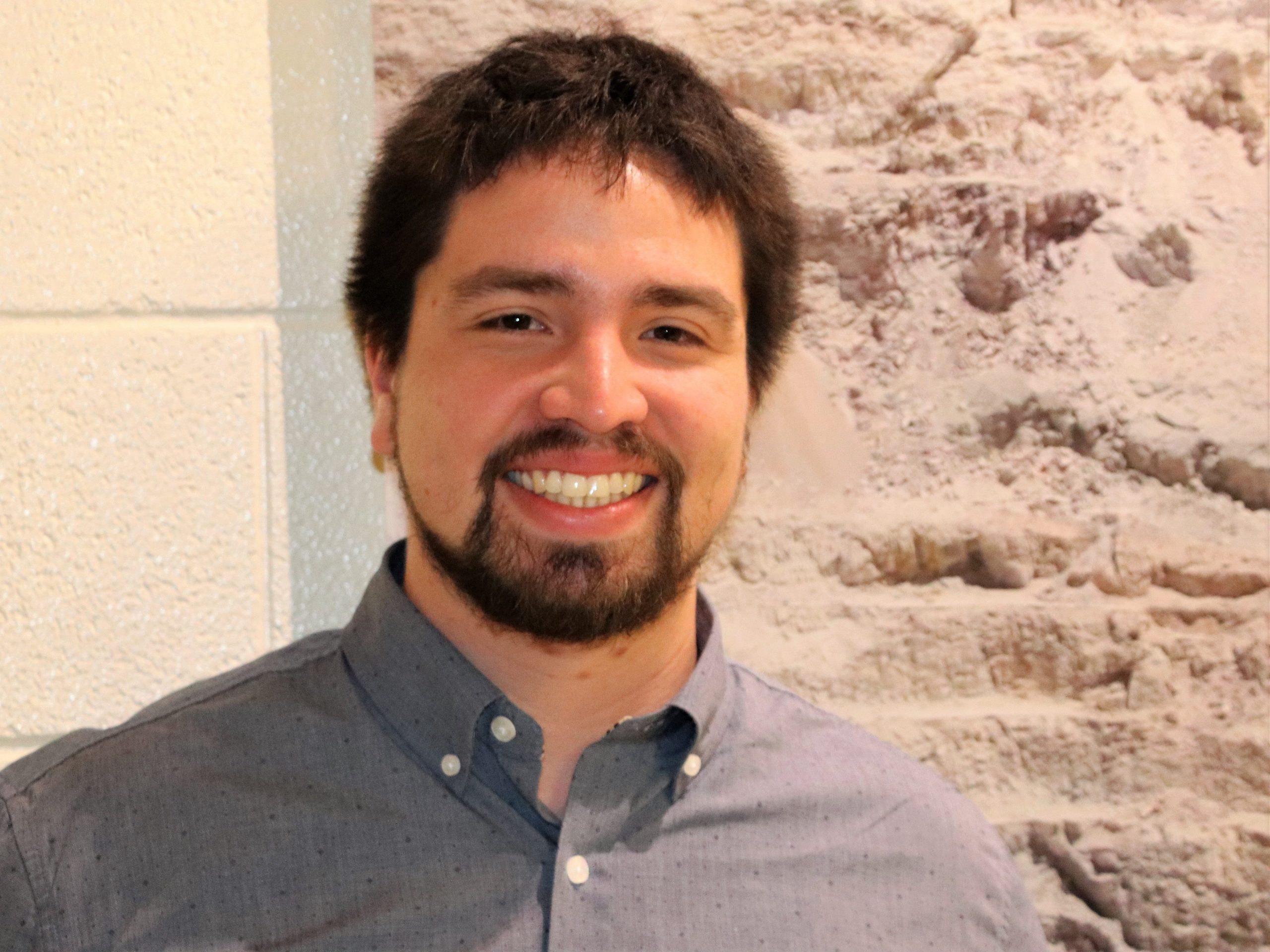
Congratulations, Alvaro!
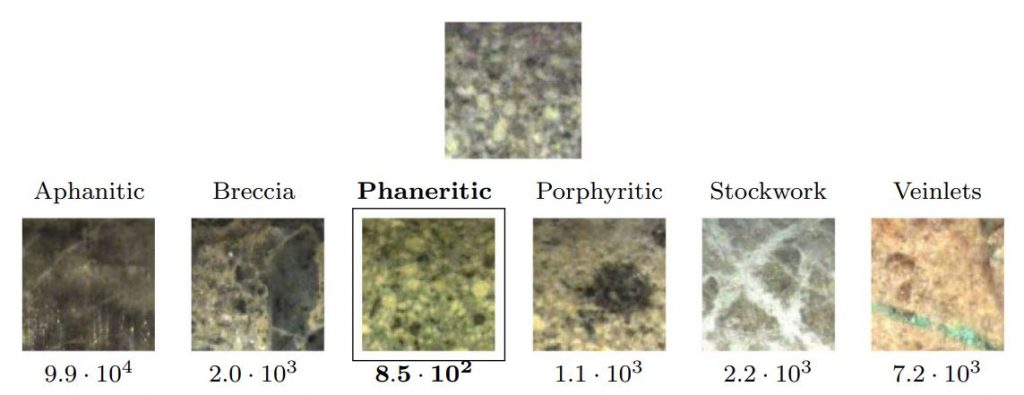
In the May 2020 issue of Mathematical Geosciences, the paper Variogram-based descriptors for comparison and classification of rock texture images was published. This work is the result of the Ph.D. in Mining Engineering of Gonzalo Diaz, at Universidad de Chile, and is the result of collaboration with Prof. Jorge Silva, hist student Rodrigo Lobos, and the researcher from ALGES laboratory, Alvaro Egaña. The paper can be downloaded here.
Gonzalo F. Diaz (Department of Mining Engineering / Advanced Mining Technology Center, Universidad de Chile), Julian M. Ortiz (The Robert M. Buchan Department of Mining, Queen’s University), Jorge F. Silva (Department of Electrical Engineering, Universidad de Chile), Rodrigo A. Lobos (Department of Electrical Engineering, University of Southern California), Alvaro F. Egaña (Department of Mining Engineering / Advanced Mining Technology Center, Universidad de Chile)
Abstract
Rock characterization is typically performed by geologists in mining companies and involves the analysis of several meters of drill-hole samples to describe distinctive geological properties. In this procedure, rock texture is not typically taken into account despite its importance given its close relation with metallurgical responses and, therefore, all mineral processes. To support the work of geology experts, this research seeks to obtain rock texture information, discriminating it from digital images through image processing and machine learning techniques. For this purpose, a geologist-labeled digital photograph database was used with different rock texture classes (including geological textures and structures) from drill-hole samples. To characterize rock texture, three texture descriptors based on variographic information are proposed, which summarize data contained in the image pixels, focusing on local structural patterns that numerically describe its texture properties. Then, based on a methodology of image texture comparison, which could be extended to classify different types of rock texture classes, a quantification of the system’s performance was obtained. The results showed a high discrimination among common texture classes using compact variogram-based features that outperformed previous methods applied on the same rock texture database.
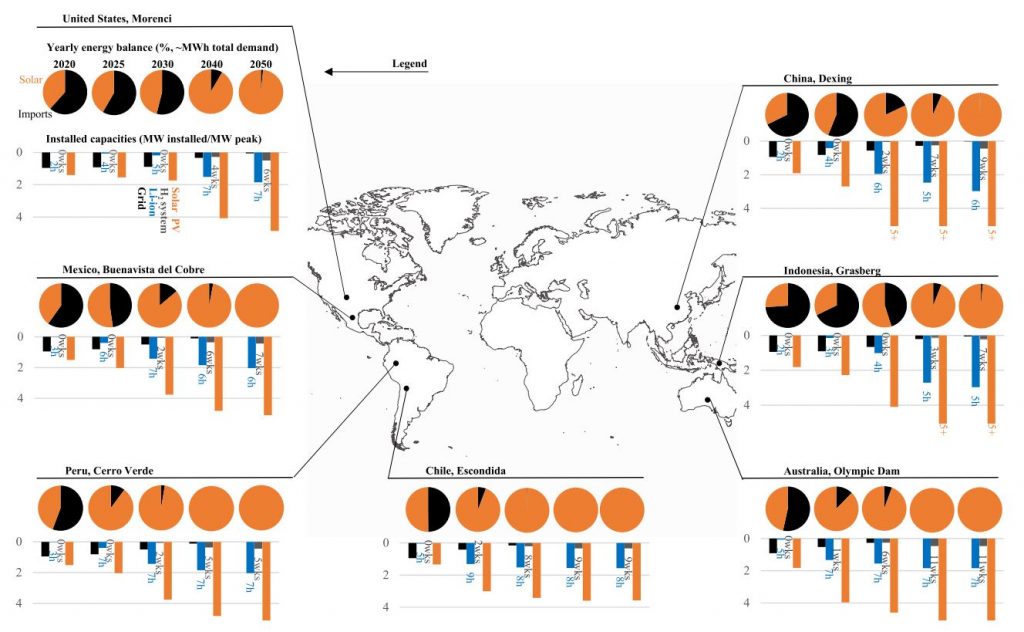
In March 2020, this publication came out. Work done in collaboration with colleagues from University of Stuttgart, German Aerospace Center, University of Waterloo, University of British Columbia and Universidad de Chile. The paper can be downloaded here.
Jannik Haas (Department of Stochastic Simulation and Safety Research for Hydrosystems (IWS/SC SimTech), University of Stuttgart / Department of Energy Systems Analysis, Institute of Networked Energy Systems, German Aerospace Center (DLR)), Simón Moreno-Leiva (Department of Stochastic Simulation and Safety Research for Hydrosystems (IWS/SC SimTech), University of Stuttgart), Tobias Junne (Department of Energy Systems Analysis, Institute of Networked Energy Systems, German Aerospace Center (DLR)), Po-Jung Chen (Mechatronics Engineering, University of Waterloo), Giovanni Pamparana (Norman B. Keevil Institute of Mining Engineering, University of British Columbia), Wolfgang Nowak (Department of Stochastic Simulation and Safety Research for Hydrosystems (IWS/SC SimTech), University of Stuttgart), Willy Kracht (Department of Mining Engineering, University of Chile / Advanced Mining Technology Center (AMTC), University of Chile), Julián M. Ortiz (Robert M. Buchan Department of Mining, Queen’s University)
Abstract
Extracting copper is energy-intensive. At the same time, copper is a key material for building the energy systems of the future. Both facts call for clean copper production. The present work addresses the greenhouse gas emissions of this industry and focuses on designing the future electricity supply of the main copper mines around the world, from 2020 to 2050, using distributed solar photovoltaic energy, storage, and a grid connection. We also consider the increasing energy demand due to ore grade decline. For the design, we use an optimization model called LEELO. Its main inputs are an hourly annual demand profile, power-contract prices for each mine, cost projections for energy technologies, and an hourly annual solar irradiation profile for each mine. Our findings show that it is attractive for the mines to have today a solar generation of 25% to 50% of the yearly electricity demand. By 2030, the least-cost solution for mines in sunny regions will be almost fully renewable, while in other regions it will take until 2040. The expected electricity costs range from 60 to100 €/MWh for 2020 and from 30 to 55 €/MWh for 2050, with the lower bound in sunny regions such as Chile and Peru. In most locations assessed, the low cost of solar energy will compensate for the increased demand due to declining ore grades. For the next steps, we recommend representing the demand with further detail, including other vectors such as heat and fuels. In addition, we recommend to include the embodied emissions of the technologies to get a more complete picture of the environmental footprint of the energy supply for copper production.
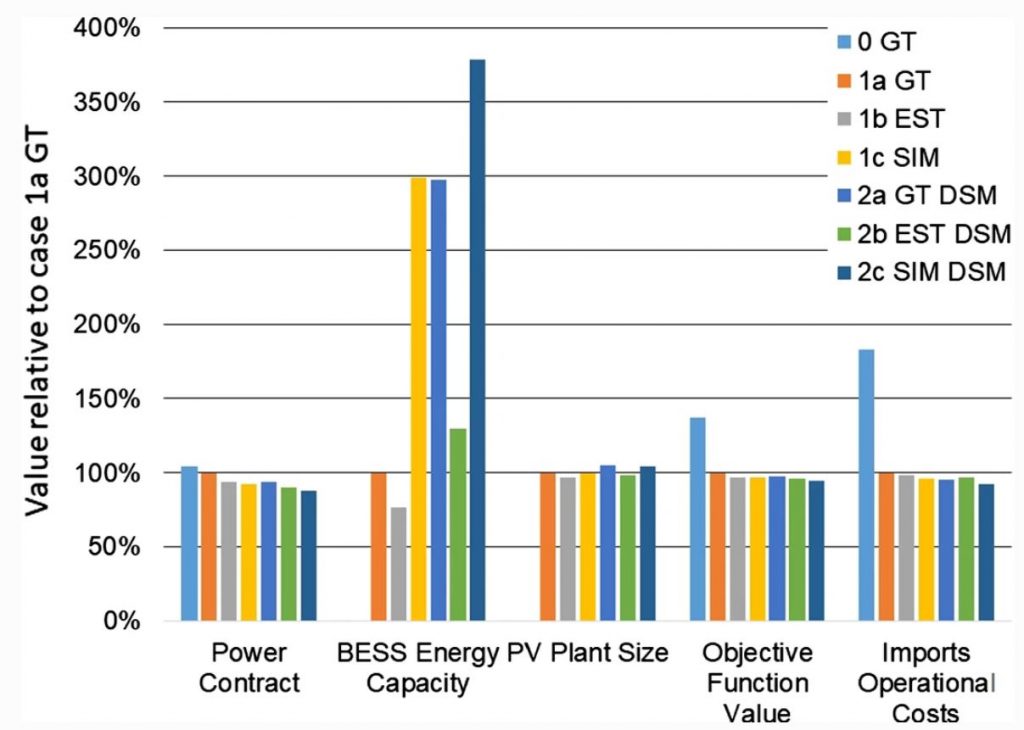
A new paper was published in July 2019 in Mathematical Geosciences: Optimization of a SAG Mill Energy System: Integrating Rock Hardness, Solar Irradiation, Climate Change, and Demand-Side Management. This is an extension of the work presented at Geoenv 2018. The paper can be downloaded here.
Julian M. Ortiz (Robert M. Buchan Department of Mining, Queen’s University), Willy Kracht (Department of Mining Engineering, Universidad de Chile / Advanced Mining Technology Center (AMTC), Universidad de Chile), Giovanni Pamparana (Department of Mining Engineering, Universidad de Chile / Advanced Mining Technology Center (AMTC), Universidad de Chile) & Jannik Haas (Energy Center, Universidad de Chile / Department of Stochastic Simulation and Safety Research (IWS/RC SimTech),
University of Stuttgart)
Abstract
Integration of renewable energy into mining and processing operations is becoming necessary as part of a strategy towards sustainability in the minerals industry. A solar photovoltaic plant along with a battery energy storage system (PV-BESS) can provide a long-term solution to cope with increasing energy costs, thus reducing the tension with other societal competing needs for a key resource such as clean energy. However, sizing these systems is challenging, in face of uncertain ore grindability and solar power availability. In this paper, we present an application of an integrated model to size the PV-BESS, where the variability of ore grindability is modeled using geostatistical tools, solar irradiance variability is captured using a Markov chain simulation model, and the entire system is optimized through linear stochastic optimization, considering a fixed mine schedule for the feed of a semiautogenous grinding (SAG) mill. The main goals are to minimize the costs associated with operating the SAG mill in the presence of a PV-BESS system, understand how the sizing and costs change under the influence of stochastic drivers, and reveal the potential for demand-side management in mines. The size and costs of the necessary infrastructure are determined for a model of estimated grindability and an ensemble of 50 simulated models of grindability, and compared against the sizing and cost of the ground truth. The effect of climate change on solar energy availability is accounted for by forecasting the ratio of excellent, good, and moderate days over bad days in terms of irradiance out to the year 2030. Finally, the effects of stockpiles and feed control according to the processing plant needs, namely a demand-side management approach, are evaluated to reveal the impact on the energy requirements and the sizing of the photovoltaic and storage system. The model is optimized considering a yearly cost function, with hourly resolution for the solar irradiance and hardness models. The results show that integrating solar power into the operation of a SAG mill has potential to reduce the total energy cost by 27%. Robustness against climate change can be achievedwith an increase in total cost of 1%. Finally, use of stockpiles to manage the ore supply to the mill and minimize the energy cost to process it results in a cost reduction of around 2%, which should offset the rehandling cost of managing the stockpiles.
Sebastian Avalos is now a Ph.D. candidate, after successfully passing his comprehensive examination. The committee was composed by:
The examination was held remotely.
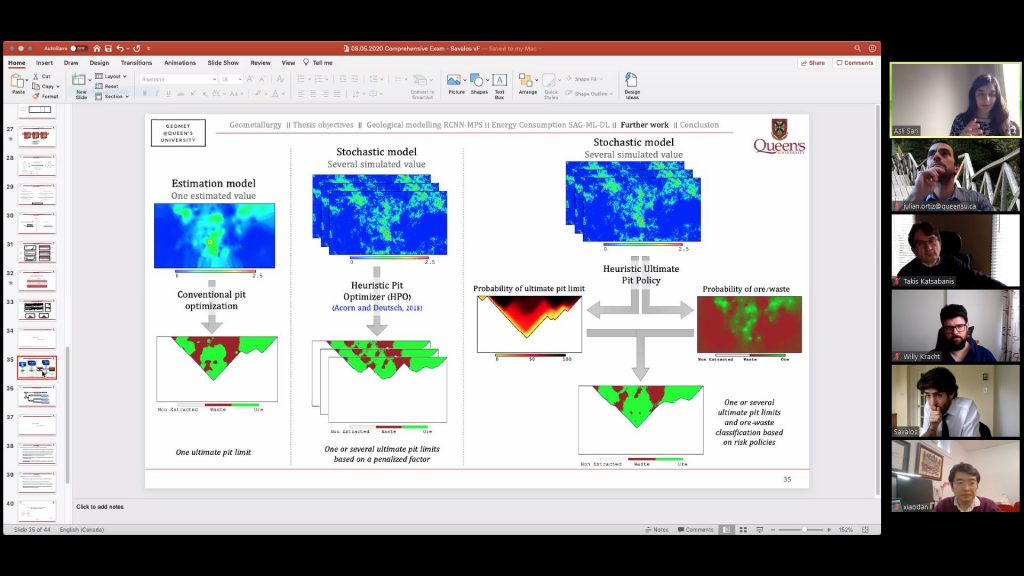
Congratulations Sebastian!!
Mauricio Garrido from Universidad de Chile is visiting our group for a few months, hoping to interact with other researchers despite the Coronavirus outbreak.
Mauricio is a Ph.D. candidate in the Department of Geology at Universidad de Chile, working on geometallurgy in porphyry copper deposits.
Welcome!
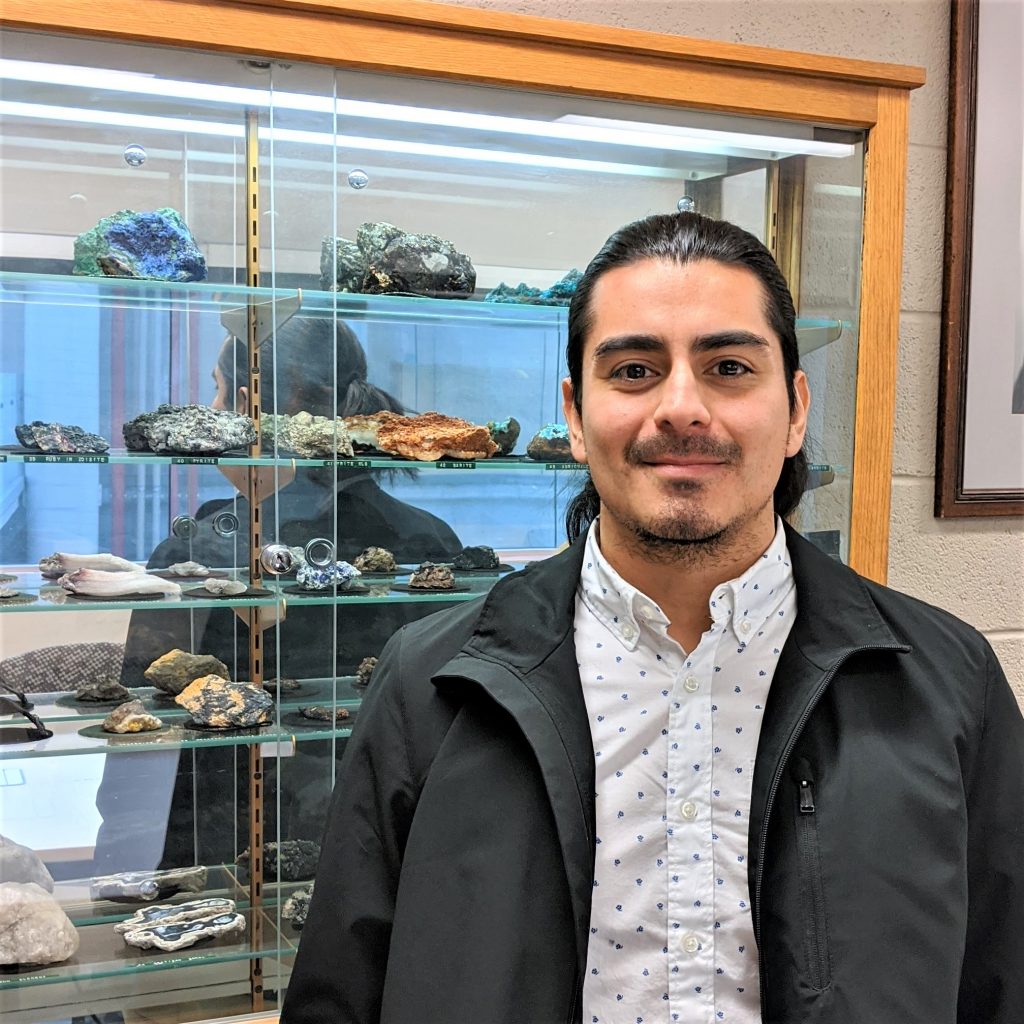
S. Ilkay Cevik presented the poster “A combined multivariate approach analyzing the geochemical data for knowledge discovery: the Vazante – Paracatu Zinc district, Minas Gerais, Brazil” coauthored by Prof. Gema R. Olivo and Prof. Julian M. Ortiz, at PDAC – SEG Student Mineral Colloquium.
The poster shows a methodology to interpret geochemical data by domaining with advanced statistical tools (t-SNE and PCA). This allows defining new targets for exploration.
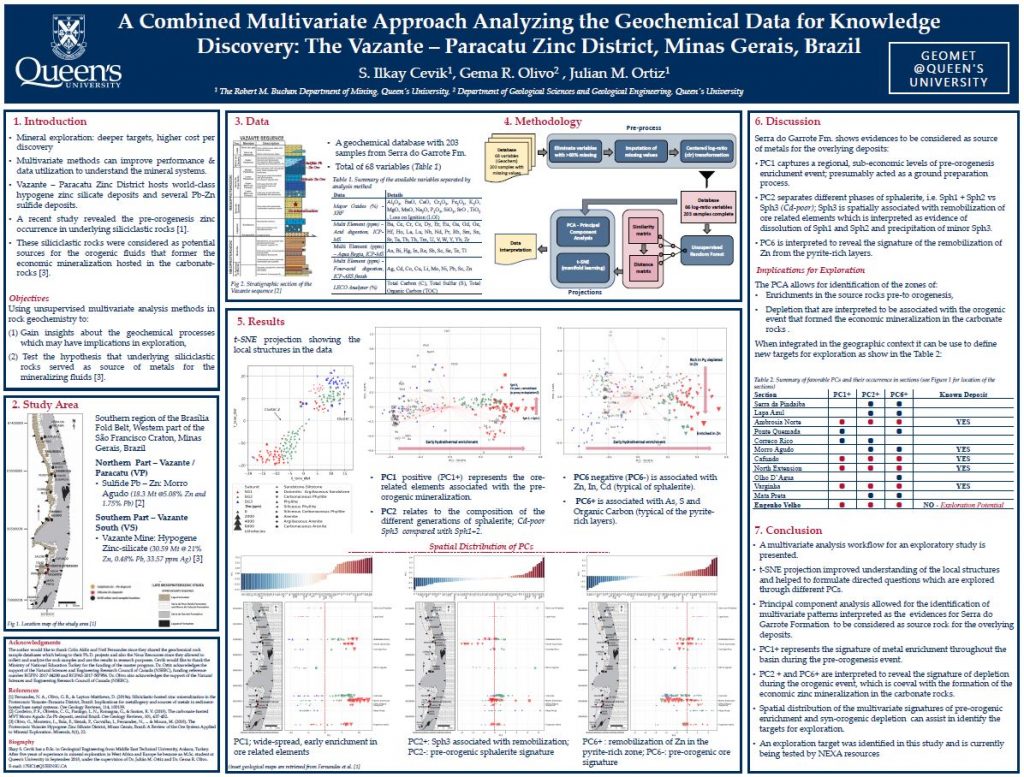
Ilkay Cevik presented his poster “A combined multivariate approach analyzing the geochemical data for knowledge discovery: The Vazante – Paracatu Zinc district, Minas Gerais, Brazil” in collaboration with Prof. Gema Olivo from the Department of Geological Sciences and Geological Engineering at Queen’s University.
He got the 3rd place in the Master’s category.
Congratulations Ilkay!!
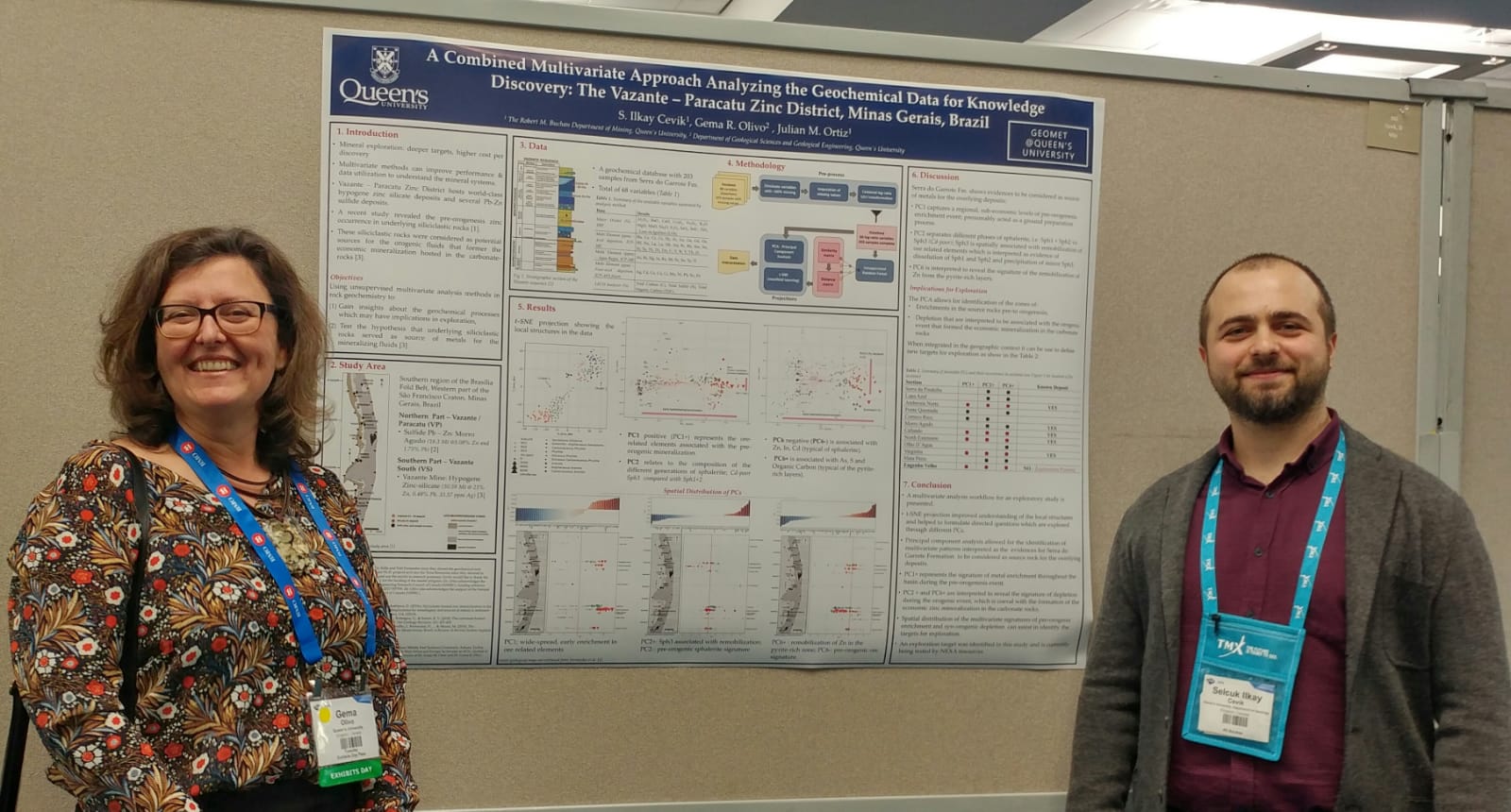
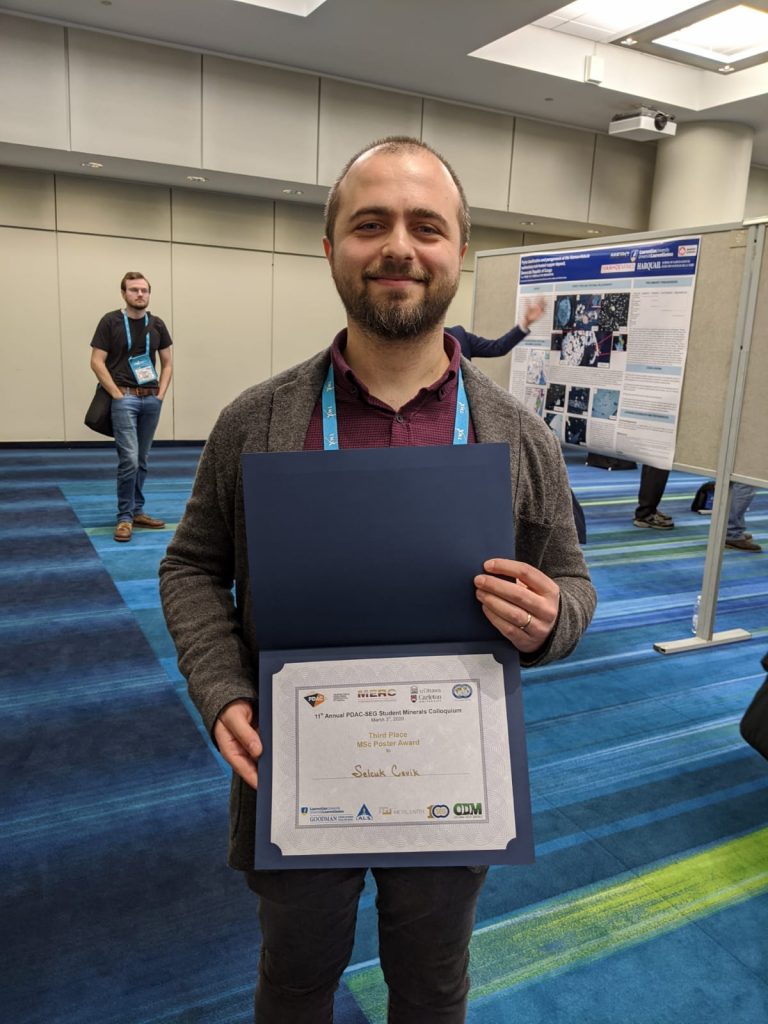

On December 16, 2019, Maria Bolgkoranou successfully defended her M.A.Sc. in Mining Engineering thesis entitled: “Multivariate Geostatistical Simulation of Compositional Data Using Principal Component Analysis“
Congratulations!
